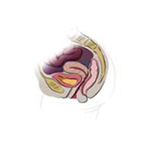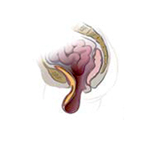Robot Assisted Sacrocolpopexy
What is Uterine & Vaginal Vault Prolapse?
Each year in the United States, over 120,000+ cases of uterine and vaginal vault prolapse are surgically treated each year. Prolapse (or dropping) of any pelvic floor organ (vagina, uterus, bladder or rectum) occurs when the connective tissues or muscles within the body cavity are weak and unable to hold the pelvis in its natural orientation. The weakening of connective tissues accelerates with age, after child birth, with weight gain and strenuous physical labor. Women with moderate to severe uterine or vaginal vault prolapse can experience prolapse through their vagina (externally), as shown in the diagrams below.
Normal Anatomy

Uterine Prolapse

Vaginal Prolapse

Women experiencing pelvic organ prolapse typically report feeling or seeing a vaginal bulge and may also have problems with urinary incontinence, vaginal ulceration, sexual dysfunction and/or having a bowel movement.
What is Sacrocolpopexy?
Sacrocolpopexy is a procedure to surgically correct vaginal vault or uterine prolapse where mesh is used to hold the vagina in the correct anatomical position.
Sacrocolpopexy has traditionally been performed as an open surgery. A 15-20 cm horizontal incision is made in the lower abdomen in order to manually access the intra-abdominal organs, including the uterus.
Fortunately, less invasive options are available. For some for complex hysterectomies and other gynecologic procedures, robot-assisted surgery may be the most effective, least invasive treatment option.
Robotic Sacrocolpopexy: A Less Invasive Surgical Procedure
If your doctor recommends sacrocolpopexy, you may be a candidate for Robot Assisted Sacrocolpopexy.
This procedure uses a state-of-the-art surgical system designed to help your surgeon perform a minimally invasive surgery through small incisions. Through these tiny, 1-2 cm incisions, surgeons can operate with greater precision and control, minimizing the pain and risk associated with large incisions while increasing the likelihood of a fast recovery and maintaining excellent clinical outcomes.
What are the advantages of this approach?
For most women, Robot Assisted Sacrocolpopexy offers numerous potential benefits over a traditional open approach, including:
- Significantly less pain
- Less blood loss and need for transfusions
- Less risk of infection
- Less scarring
- Shorter hospital stay
- Shorter recovery time
- Quicker return to normal activities
Why Come to UMMC?
At the University of Maryland, we offer compassionate care from nationally recognized specialists in the field. The University of Maryland's Division of Urology and Female Pelvic Medicine and Reconstructive Surgery has physicians with advanced surgical skills who have access to technology available at only a handful of medical centers in the country. Because of this, we are able to offer state-of-the-art care for patients in need of traditional and advanced surgical procedures.
There is not one type of surgery that is appropriate for everyone. You and your physician will decide on an individualized treatment plan depending on your stage of prolapse, your complaints, and most importantly, your preferences. At the University of Maryland, a multi-disciplinary and patient-centered treatment approach assures the most comprehensive and integrated care for your pelvic floor disorder.
More Information & Appointments
For more information or to make an appointment, please call 1-866-608-4228.
